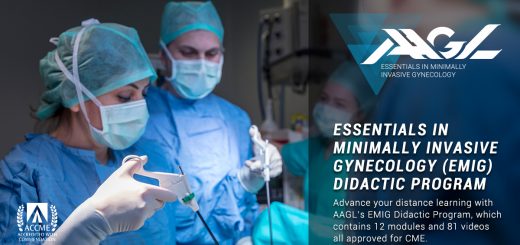Endo SIG Difficult Case: Vaginal Endometroisis

Last year we have featured cases and articles from AAGL’s Special Interest Groups (SIG) and in this issue, the Endometriosis SIG takes center stage! The most difficult case has to deal with Vaginal Endometriosis including a special narrated video by Dr. Cindy Mosbrucker, MD.
Thank you to all the AAGL SIG chairs, vice-chairs, and members – for the informative and timely articles and for your continued support this exciting series!
Rectovaginal endometriosis is the term for one of the most severe forms of endometriosis, and one that requires significant skill to surgically extirpate. Pure vaginal endometriosis, however, is underappreciated and understudied. A brief literature search using the terms “incidence, frequency, vaginal endometriosis” revealed numerous studies about various aspects of rectovaginal endometriosis, but only one that listed the relative frequency of involvement of the vaginal epithelium in patients with rectovaginal disease. That study (1) indicated that 84% of patients had vaginal excisions, which is much higher than overall incidence in all rectovaginal nodules so the true incidence of vaginal endometriosis remains unknown. From personal experience, in 16 years of practice focused primarily on endometriosis the incidence is well less than 3% and probably closer to 1%. Nodules that are visible in the posterior fornix or even palpable nodularity portends severe disease that is more invasive and fibrotic than the average case of rectovaginal disease which is typically confined to the rectovaginal septum. In addition, the location of the accompanying rectal nodule tends to be closer to the anus which translates to more potential complications from low or ultra-low anterior resection. One technique for resecting vaginal endometriosis has been described by Angioli et al. (2) It involves first circumscribing the vaginal lesions with pencil cautery from below, then dissecting laparoscopically from above. This technique is not universally accepted as there can be difficulties when trying to meet the 2 incisions. Our preference is to skip the vaginal dissection from below and follow the plane between the nodule and the cervix laparoscopically or robotically. This will lead caudally into the vagina and allows for visualization of the nodule from above and the entire lesion can then be circumscribed and closed robotically. The rectal disease can then be treated in the appropriate manner for the size of the lesion. We also interpose fat between the two incisions to minimize the risk of fistula formation. We either use the sigmoid mesentery in the case of a LAR, or pararectal fat mobilized and sutured over the rectum.
Surgical excision of rectovaginal endometriosis has been shown to be quite effective for both pain relief and fertility. (1,3) Nerve sparing techniques have been described which lower the risk of autonomic bowel and bladder dysfunction. (4)
This is the case of a 35yo P0 female desirous of fertility who presented with infertility, dysmenorrhea, dyspareunia, and dyschezia during her menses. She had 2 prior surgeries for endometriosis, one in 2015 where she was found to have stage 3 disease and underwent a left ovarian cystectomy. The other was in 2019 where she was found to have severe adhesive disease with inability to visualize the left adnexa due to adhesions of the sigmoid to the posterior uterus and left round ligament. No intervention was performed but photos were taken and she was referred to me for definitive surgical management.
On pelvic exam she had a tender mass in the posterior fornix just left of the cervix. Visualization of the mass in the office was not possible due to pain with attempted manipulation of the fixed cervix. TVUS showed a large mass in the rectosigmoid measuring 4.6 x 1.25 x 2.8 cm. She also had a large (5.5cm) hemorrhagic cyst consistent with an endometrioma in the left adnexa.
Treatment options were discussed and the patient was consented for robotic excision of endometriosis, left ovarian cystectomy, and resection of rectovaginal endometriosis with possible low anterior resection.
At surgery vaginoscopy was performed which allowed visualization of the posterior fornix mass containing several small endometriomas which were 3-4mm and blue appearing. Laparoscopy showed findings consistent with her prior surgery. After freeing the sigmoid from the left adnexa, the tube could not be visualized separate from the ovary. As the enterolysis tracked down towards the cervix the endometrioma ruptured revealing the fimbria within the cyst itself. The tube was severely dilated and the endometrioma was densely adherent to the ureter, hypogastric, uterine, and superior vesicle arteries, as well as the obturator nerve and vessels. As there was minimal normal ovarian tissue the decision was made to remove the entire left adnexa. Once this was accomplished the rectum was dissected off the posterior uterus and cervix. A sponge stick was placed in the posterior fornix which allowed the mass effect of the vaginal nodule to be visualized from above, and the dissection was carried out between the cervix and the mass resulting in entry into the vagina. The cystic areas visualized on vaginoscopy were seen and the entire mass was able to be resected robotically. It was adherent to the rectal mass but not one and the same. Due to the size of the rectal mass a low anterior resection was required but the anastomosis was 2-3cm above the reflection so a diverting ileostomy was not required. Postoperatively she did well with immediate resolution of her preop pain. Her surgery was too recent to evaluate its effect on fertility.
In summary, vaginal endometriosis should be considered to be a marker for advanced stage disease including deeply infiltrating nodules in the uterosacrals, parametrium, and large rectal nodules that require surgical intervention by a multidisciplinary team familiar with this presentation of endometriosis.
1. Darai, et al. Ann Surg 2010;251: 1018–1023
2. Anjioli, et al. Eur J Obstet Gynecol Reprod Biol. 2014 Feb;173:83-7.
3. Tarjanne, et al. Acta Obstetricia et Gynecologica. 2010; 89: 71–77
4. Mangler, et al. Int J Gynaecol Obstet. 2014 Jun;125(3):266-9.






